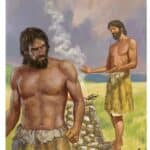For many, the term “ancient” implies drudgery and irrelevance. However, the outset of this book will dispel any such notions. The ancient age brims with interest, instruction and encouragement for today’s readers. This was an age of miracle-working apostles, fearless martyrs and stalwart church fathers; an age that preserved the Scriptures, drafted the early creeds and produced timeless Christian classics; an age when the church was buffeted by fierce waves of persecution and assailed by heresies of every sort. Through this volume and the ones that follow, the Lord Jesus Christ, the cornerstone of the church, sovereignly shepherded His beloved church by His Word and Spirit.
In this first volume of Christ and His Church Through the Ages, author and historian Herman Hanko tells the fascinating story of the early church during the first six centuries of the New Testament dispensation. He relates how Christ faithfully guided the church from the ministry of the apostles through the fall of the Roman Empire. Highlights of this history include the outpouring of the Holy Spirit at Pentecost, the spread of the gospel to the Gentiles, the persecution of the church under Roman emperors, the deliberations of the ecumenical councils and the battle for the truth of sovereign grace.
Through this and future volumes, students of church history and interested readers will surely grow in their love and appreciation for the saga of Christ’s church. They will find church history to be, as the author once affectionately described it, “the exciting adventure of the marvelous work of grace.”
Herman Hanko served as professor of church history at the Theological School of the Protestant Reformed Churches from 1965 until his retirement in 2001. He is the author of several books, including Portraits of Faithful Saints, Contending for the Faith and For Thy Truth’s Sake: A Doctrinal History of the Protestant Reformed Churches.
Dan Van Uffelen is a church history teacher at Covenant Christian High School in Walker, Michigan. He has taught church history for almost two decades.
[Reviewed by Prof. Douglas Kuiper, current professor of church history at the Protestant Reformed Seminary]
The RFPA website currently lists ten titles written by Herman Hanko, emeritus professor of Church History and New Testament Studies at the Protestant Reformed Theological Seminary. Publishing this survey of church history will add four more titles to those ten. These four may well be Hanko’s magnum opus.
The four volumes correspond to the four main eras of church history—ancient, medieval, Reformation and modern. The RFPA’s goal is to publish one volume per year for the next four years. Under review is the first volume, covering the first six centuries of church history. Three chapters cover the first period of ancient church history, the apostolic period (30–100). The material in this section is largely based on God’s revelation in Scripture.
Chapters four through ten cover the post-apostolic period (100–313). During this period the church was learning how to live, grow and develop in her doctrinal understanding without the guidance of the apostles. Society and the Roman government hated the church during this era. She battled against heresies that consisted of mixtures of Christian teachings and pagan philosophy, she had to recognize which books constituted the inspired Scriptures and she had to develop in her understanding of the Trinity. By God’s grace and under Christ’s direction, grow and develop she did.
Chapters eleven through nineteen cover the Nicene and post-Nicene period (313–590). During this time, the state stopped persecuting the church and began to favour her, to her weakening. The seeds of the Romish papacy were sown and began to sprout. Notable doctrinal controversies regarding the Trinity, Christ’s Person and natures, and the depravity of man’s nature also characterized this period. The church was working hard to develop in her understanding of the sovereign, irresistible character of God’s grace.
All of which is to say that this book highlights the main events and themes in the history of the church during her first six hundred years—exactly as you would expect it to do and as do many other books. So what makes this book different?
First, the work is intended for a wide public audience, not the narrow field of scholarship. Hanko is a scholar. He is well read in the field of church history and taught it at seminary level for thirty-six years. But his goal is that the members of the church, whether highly educated or not, know the basic points of church history.
Second, Hanko’s goal is to make the reading of church history an enjoyable undertaking: “I have consciously tried to make the book enjoyable and worth reading” (author’s Preface). Indeed, the book tells a story and flows like a story. It is a story—a true story, His (God’s) story.
Other surveys of church history are also intended for a wide audience and are entertaining reads. So the third, and fundamental, way in which this book is different is that it evaluates church history from a Reformed and biblical viewpoint. In Hanko’s words, “While the books that I read were all helpful in giving the facts of church history, some in considerable detail, I could not find one book that dealt with the history of Christ’s church from a biblical and, more specifically, a Reformed viewpoint” (Preface).
In this reviewer’s judgment, Hanko accomplishes all three goals and does so well. His writing style is engaging. His explanation of complex matters (Gnosticism, and the Trinitarian and Christological heresies, for example) is simple enough that the book could be used as a high-school textbook (in fact, the first edition was a limited edition release for that purpose). And Hanko’s evaluation of his material in light of Scripture is refreshing.
The book is full of church history facts, but the analysis of the historical events and themes is this book’s great value. Every historian has a bias, a perspective from which he views history. Some historians, trying to be objective, do not tip their hand as to what their bias is. Hanko tips his hand: history is the unfolding of God’s counsel, directed by the ascended Lord. It is the outworking of principles of history that Scripture tells us to expect—the signs of the times of our Lord’s return. It is the story of men and women who sometimes abided by scriptural principles and requirements, and other times failed to abide by them.
Hanko also leaves the reader with the clear impression that the history of the church long ago is relevant for us today. History’s themes repeat themselves and the heresies that the church battled then are fundamentally the same, though repackaged, as some of the heresies that the church faces today.
I thank my former professor for taking the time to write the book and look forward to the release of the next three volumes.
The contributions of the editor and reviser, Dan Van Uffelen, are also commendable. Dan lists the ten basic categories in which he revised the first edition. Dan’s work was significant and time-consuming. The addition of introductory essays, biographical sketches, sidebars, charts and pictures makes the book more enjoyable to read, and more suitable for a textbook. The addition of an index to the book is also welcome.
The subject matter is precious. The matter is presented at a level that many can read. RFPA subscribers will not only enjoy reading the book but likely recommend it to others interested in the church’s history.










